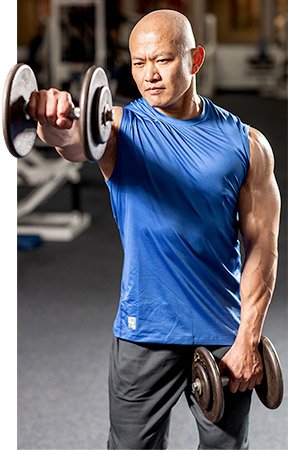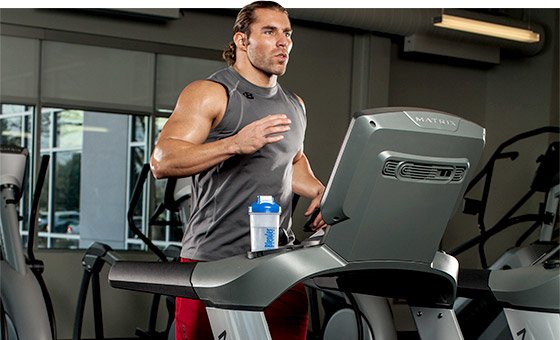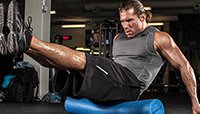When I was in my 20s, training was easy. A warm-up consisted of walking into the gym, cool-downs were nothing more than crushing a protein shake, and mobility work was something best left to the freaks in a yoga class. I'd train, go to work, come home, eat, and then do it all over again the next day without any real soreness or stiffness. Injuries didn't happen because I was immortal, and if they did, they healed quickly with some harder workouts and a night out with the guys.
Now that I'm in my 30s, the protocol has changed a bit. I find an actual benefit from a dedicated warm-up, and the cool-down helps keep soreness from becoming a detriment the following day. Injuries from being stupid in my 20s are now something that have to be addressed and worked around, and training with all-out intensity is cycled to allow for recovery and adaptation versus just blindly pushing through mind-numbing intensity all the time.
Pretty soon I'll be in my 40s, and I'll have to continue making adjustments thanks to Father Time. While I'm not giving up the lifting belt, I'll have to make a few more concessions to ensure I remain active and allow for performance improvements on a regular basis. Here are four must-try tweaks for the aging trainee.
1
Take More Time to Prepare for Training
Tendons and ligaments tend to lose elasticity over time. As you age, they wind up becoming stiffer and less forgiving. They take a little longer to become pliable when you start your workout than they did in earlier years, so spending a few minutes doing warm-up sets of a multi-joint movement is time well-spent.
Dean Somerset Hanging Lat Stretch With Squat
Watch The Video - 0:35
Consider first the ambient temperature and humidity. If it's close to freezing and humidity is low, it could take considerably longer to warm up connective tissue than if the temperature is closer to body temperature. Where I live in Edmonton, during the winter it can get to -40°, so the warm-up would have to be somewhat longer than if I lived in a warmer climate like San Diego.
Prior to your planned workout, spend some time doing cardio-based exercise to increase blood flow and muscle temperature, then move on to some low-intensity general movements that will mimic the movements you're going to do later in your workout. If you're training legs, do some light stretching and squat pattern training, as shown in the videos below, to get you supple and move your tissues prior to loading up the plates.
Dean Somerset Squat IR ER Mobility
Watch The Video - 0:27
2
Invest In Mobility Movements
Over time, all joints wind up going through degenerative processes, and yours are no exception. The more active you were through your youth, the more likely you'll need to spend time on maintaining and improving mobility through some key centers—your hips, thoracic spine and ankles—in order to continue doing physical activity. This is especially true if you've been involved in contact sports like hockey, football, or rugby.
I remember watching WWE superstar Triple H in his mid-40s work out with Joe DeFranco as he was getting ready for WrestleMania a few years ago. Regardless of whether you consider the activities onstage sport or entertainment, these athletes/entertainers still have to make their bodies do the work to make it look like they're getting hit with full force. Triple H had accumulated a lot of injuries over 20 years in the ring, and it showed.
Dean Somerset Half Kneeling Elastic Arm Rotations
Watch The Video - 0:35
The first half of his workout was dedicated to maintaining and improving his mobility through his hips, spine, shoulders, and ankles. The rest was dedicated to strength, power, conditioning, and generally looking like a complete badass in the ring. This approach can work not only for beat-up pro wrestlers still at their peak, but also for bodybuilders and regular lifters.
Two simple mobility series you can work through to help the hips and spine are the half-kneeling rotation with an elastic band, and a hip-kneeling rocking matrix. Check out these videos for detailed instruction.
Dean Somerset Quadruped Rocking Mobility Matrix
Watch The Video - 2:45
Make sure you're taking 3-5 seconds to inhale and exhale on each rep. If you're willing to spend 10 minutes on mobility at the start of each workout, you'll have a much better workout, and a much easier time getting out of bed the following morning.
3
Reduce Training To Failure

Maximum hypertrophy typically involves taking a muscle to its most fatigued state, but over time a muscle's ability to grow is mitigated by the connective tissue's ability to recover from these workouts. Ligaments and tendons don't adapt to workout stressors as quickly as muscles do, since muscles have specialized satellite cells that help them go through active remodeling. As a result, training intensity needs to be moderated to allow for reduced stress on the connective tissue.
One of the easiest ways to do this is to refrain from taking every set to absolute failure. If the ligaments and tendons don't recover from previous workouts, repetitive strain ailments like tendinitis and fasciitis can become a reality. This doesn't mean you should never push yourself to the max; just save failure for the last set of every exercise, rather than each and every set.
Another consideration is max weight being lifted. In your early 20s, you could probably do a max deadlift each workout and rebound without much effect; in your 40s, it may have to be cycled so max-effort work is done just once each month. The remainder of your workouts would be focused on sub-max levels—perhaps 80-90 percent intensity—while working on the technique and mobility requirements of each lift. This doesn't necessarily mean your workouts will be easy, just that the total weight lifted won't be maximal each workout.
4
Spend Time Doing Actual Cardio
Cardio sucks when you're 20, and it still sucks when you're 40. But remember that your heart is a muscle, just like your biceps, though it's got a slightly different makeup. When you lift heavy, your blood pressure increases; when you stop, it decreases. This pressure change on a recurring basis can, over the long term, lead to less-than-desirable changes, such as left ventricular hypertrophy and decreased cavity volume. It can also be one of the factors involved in atherosclerotic plaque formation in the cardiac arteries and veins, which could lead to a blockage and eventual heart attack.
Some substances—including steroids —have been shown to have a direct action on this change, and can lead to an increased risk of injury to the heart itself. If you have a family history of heart problems, your risk is elevated even further.
One way to reduce risk is through the involvement of some steady-state, cardio-based activity that works at a level slightly below your anaerobic threshold. This zone is one in which you could perform the "talk test," where you'd be able to hold a conversation with someone next to you, albeit in short sentences.

As an example, if you'd normally be able to run on a treadmill at 6.0 mph and maintain a relatively easy level of effort, but 6.5 would cause you to hate life and force you to stop after about three minutes, then 6.0 mph would be your target zone. Maintain this heart rate for 20-30 minutes a workout, and try to get in three cardio workouts each week to help with cardiac remodeling.
Lower-intensity cardio workouts are also valuable. These could be simply walking through the neighborhood, biking with your family, or anything where your heart rate is above resting without much actual effort. These workouts may not have a direct impact on your body composition, but they can have a massive impact on your heart health and your overall quality of life.
Fit Far Beyond 40
There's a saying that 40 is the new 20. Apparently orange is the new black, as well. What hasn't changed is that you want to keep working out and seeing the kind of progress you've likely seen for the last 20-30 years, regardless of your age. There's no finish line when you're 40—just a couple of small considerations to help you continue to do what you love. Much like drinking enough water or getting enough sleep, these tweaks may be less than exciting, but they can make a massive difference in every other part of your life.
Recommended For You

6 Ways To Banish Muscle Soreness
Delayed onset muscle soreness is a major threat to strength training and recovery. Use these methods to defeat DOMS and conquer intense workouts!
Mobile Muscle: Your Active Mobility Plan For Increased ROM And Strength
Static stretches waste valuable time for minimal benefits that won't last. Adopt this active mobility warm-up and take your training to the next level!

